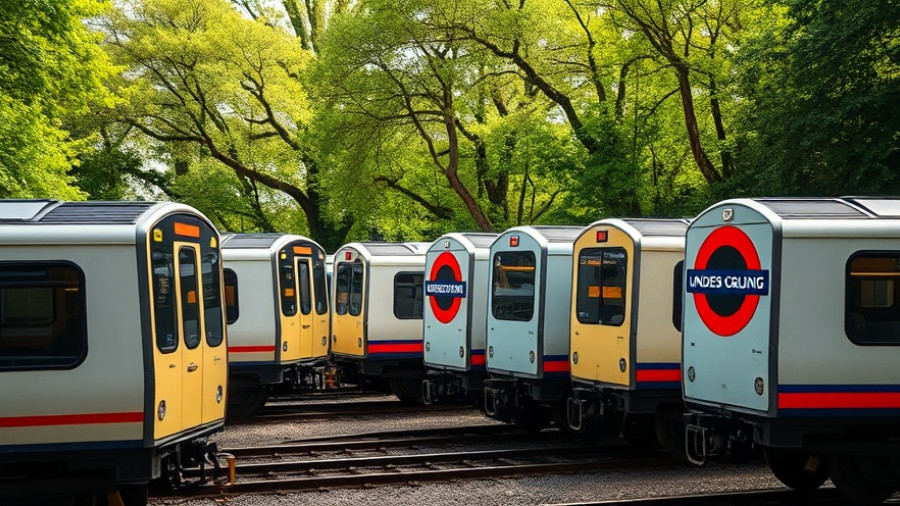
Why Lowering the Minimum Age for Train Drivers Matters to Young Londoners
The recent announcement that the minimum age for train drivers in the UK will be lowered to 18 has the potential to resonate deeply with many young adults, especially those in London aspiring to enter the workforce. The Department for Transport (DfT) has proposed this change in response to a critical driver shortage within the rail industry, a decision that not only aims to ensure more reliable train services but also opens up new career pathways for young people. By allowing 18-year-olds to step into this vital role, the government hopes to reduce delays that have been increasingly impacting London commuters.
Understanding the Current Driver Shortage
With a striking statistic revealing that nearly 87% of train cancellations are attributed to a lack of available drivers, the pressing need for fresh talent in this sector cannot be overstated. The current average age of a train driver in the UK is 48, and with 30% of the workforce nearing retirement by 2029, a generational gap in staffing is looming. This presents a pivotal opportunity for younger individuals to fill this void and contribute significantly to their communities, particularly in major urban areas like London.
Boosting Diversity in the Rail Sector
It's not just about filling seats but also about creating a more diverse workforce. Currently, fewer than 10% of train drivers are women, and under 12% are from ethnic minorities. Allowing 18-year-olds to enter the profession might encourage a more varied demographic to consider a career in rail. Mick Whelan, general secretary of the train drivers’ union Aslef, pointed out that this policy could significantly diversify the driver’s cab and attract those who might immediately pursue other job opportunities out of high school. This diversification can lead to richer, more inclusive workplace dynamics and create a rail system that reflects the communities it serves.
Learning from International Examples
Several European countries have already embraced this progressive move, with France, Germany, and the Netherlands permitting young individuals to operate trains. Learning from their experiences could streamline the integration of younger drivers into the UK rail system. Not only could this instigate a cultural shift in how we perceive rail jobs, but it may also enhance the safety and efficiency of rail services as these nations have established procedures to train drivers effectively from a young age. The commitment to maintain safety standards remains a priority as the DfT assures us that training protocols will not change despite the adjustment in age.
Creating Opportunities and Encouraging Sustainability
This decision aligns with a broader discussion on sustainable living and employment that resonates with young homeowners interested in building eco-friendly communities. With train travel being one of the most sustainable forms of transport, fostering a robust rail workforce is not only a matter of convenience but also one that supports a greener future. Young people eager to contribute to sustainable practices can find rewarding pathways in the rail sector that assist in reducing carbon footprints associated with road travel.
Why This Matters for Young Homeowners
For young homeowners in London, the implications of a reliable rail system go beyond mere convenience. A well-functioning transportation network enhances property values and community stability, making neighborhoods more attractive. As young people increasingly seek housing in areas connected to efficient rail services, the availability of a strong, youthful workforce becomes integral to fostering vibrant suburban and urban areas. Understanding these interconnections provides younger homeowners with insight into the factors influencing their investments and the overall quality of life in their communities.
Preparing for the Future of Rail Jobs
As the DfT prepares to implement this change, aspiring drivers should be encouraged to look into upcoming job opportunities that could arise as early as December. Training programs tailored for 18-year-olds are likely to be developed, and prospective candidates would be wise to familiarize themselves with the necessary qualifications. This change could mark the beginning of a new era in the rail industry, one marked by youthful ambition, increased reliability, and opportunities for growth for both individuals and communities.
As we contemplate the future of the rail system, it's essential for young Londoners to consider how they can engage with these changes actively. Whether through direct involvement in the rail sector or raising awareness about the importance of reliable public transport, being informed is the first step towards making a meaningful impact.
To stay updated on how this policy evolves and explore opportunities available in the changing landscape of train travel, young homeowners can subscribe to local news channels or follow community briefings that emphasize developments in public transportation.
 Add Row
Add Row  Add
Add 




Write A Comment